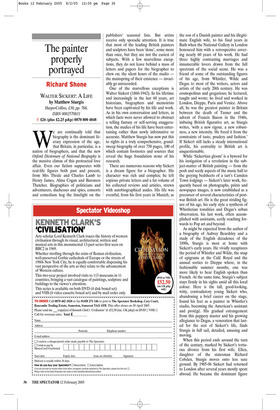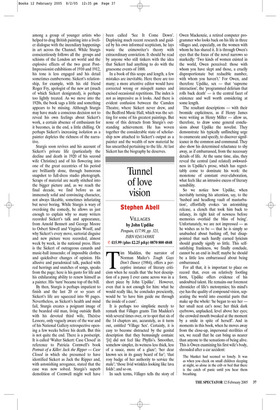The painter properly portrayed
Richard Shone
WALTER SICKERT: A LIFE by Matthew Sturgis HarperCollins, £30, pp. 768, ISBN 0002570831 ✆ £26 (plus £2.25 p&p) 0870 800 4848 We are continually told that biography is the dominant literary expression of the age, that Britain, in particular, is a nation of biographers, and that the new Oxford Dictionary of National Biography is the massive climax of this protracted love affair. Even our fiction suppurates with real-life figures both past and present, from Mrs Thrale and Charles Lamb to Henry James, Alma Cogan and Baroness Thatcher. Biographies of politicians and adventurers, duchesses and spies, consorts and comedians hog the limelight on the publishers’ seasonal lists. But artists receive only sporadic attention. It is true that most of the leading British painters and sculptors have been ‘done’, some more than once, but they are not the easiest of subjects. With a few marvellous exceptions, they do not leave behind a mass of letters and papers for the biographer to chew on; the silent hours of the studio the mainspring of their existence — invariably go unrecorded.
One of the marvellous exceptions is Walter Sickert (1860-1942). In his lifetime and increasingly in the last 60 years, art historians, biographers and memoirists have been captivated by his life and work. As in his own conversation and letters, in which facts were never allowed to obstruct a telling fantasy or self-serving exaggeration, the studies of his life have been entertaining rather than newly informative or accurate. Matthew Sturgis has now put this to rights in a truly comprehensive, grandsweep biography of over 750 pages, 100 of which contain footnotes and sources that reveal the huge foundation stone of his research.
There are numerous reasons why Sickert is a dream figure for a biographer. His character was rich and complex; he left copious private letters and a fat volume of his collected reviews and articles, strewn with autobiographical asides. His life was eventful, from his first years in Munich, as the son of a Danish painter and his illegitimate English wife, to his final years in Bath when the National Gallery in London honoured him with a retrospective covering nearly 60 years of his work. He had three highly contrasting marriages and innumerable lovers drawn from the full spectrum of the social scene. He was a friend of some of the outstanding figures of his age, from Whistler, Wilde and Degas to most of the writers, actors and artists of the early 20th century. He was cosmopolitan and gregarious; he lectured, taught and wrote; he lived and worked in London, Dieppe, Paris and Venice. Above all, he was the greatest painter in Britain between the death of Turner and the advent of Francis Bacon in the 1940s, imbuing British figurative art, as Sturgis writes, ‘with a new rigour, a new robustness, a new intensity. He freed it from the constraints of taste, prudery and fashion.’ If Sickert still lacks a steady international profile, his centrality to British art is unquestionable.
While ‘Sickertian gloom’ is a byword for his instigation of a revolution in the subject-matter of British painting — from the posh and seedy aspects of the music hall to the greying bedsheets of a tart’s Camden Town lodgings — Sickert’s later work, frequently based on photographs, prints and newspaper images, is now established as a precursor of several characteristics of postwar British art. He is the great striding figure of his age, his early style a synthesis of Whistlerian tonalities and Degas’s urban observation, his last work, often accomplished with assistants, eerily reaching forwards to Pop art and beyond.
As might be expected from the author of a biography of Aubrey Beardsley and a study of the English decadence of the 1890s, Sturgis is most at home with Sickert’s early years. He vividly recaptures the period of Whistler and Wilde, the snap of epigrams at the Café Royal and the annual sorties to Dieppe where, in the fashionable summer months, one was more likely to hear English spoken than French. At the same time, Sturgis’s subject stays firmly in his sights amid all this local colour. Here is the tall, good-looking, witty, contradictory young Sickert who, abandoning a brief career on the stage, found his feet as a painter in Whistler’s studio, becoming the American’s assistant and protégé. His gradual estrangement from this peppery master and his growing allegiance to Degas, a veneration that lasted for the rest of Sickert’s life, finds Sturgis in full sail, detailed, amusing and moving.
When this period ends around the turn of the century, marked by Sickert’s tortuous divorce from his first wife, Ellen, daughter of the statesman Richard Cobden, Sturgis moves onto less sure ground. By 1905-06 Sickert had returned to London after several years mostly spent abroad. He became the dominant figure among a group of younger artists who helped to drag British painting into a livelier dialogue with the incendiary happenings in art across the Channel. While Sturgis conscientiously follows all the groups and schisms of the London art world and the explosive effects of the two great PostImpressionist exhibitions of 1910 and 1912, his tone is less engaged and his detail sometimes cumbersome. Sickert’s relationship, for example, with his old friend Roger Fry, apologist of the new art (much of which Sickert denigrated), is perhaps too lightly treated. As we move into the 1920s, the book sags a little and something appears to be missing. Although Sturgis may have made a conscious decision not to reveal his own feelings about Sickert’s work, a certain absence of enthusiasm for it becomes, in the end, a little chilling. Or perhaps Sickert’s increasing isolation as a painter depletes the richness of the narrative.
Sturgis soon revives and his account of Sickert’s private life (particularly the decline and death in 1920 of his second wife Christine) and of his flowering into one of the great eccentrics of his period are brilliantly done, through humorous snapshot to full-dress studio photograph. Scraps of material are neatly stitched into the bigger picture and, as we reach the final decade, we find before us an immensely solid and convincing character, not always likeable, sometimes infuriating but never boring. While Sturgis is wary of overdoing the comedy, he allows us just enough to explain why so many writers recorded Sickert’s talk and appearance, from Arnold Bennett and George Moore to Osbert Sitwell and Virginia Woolf, and why Sickert’s every move, sartorial disguise and new picture were recorded, almost week by week, in the national press. Here is the Sickert of outrageous canards and music-hall innuendo; of impossible clothes and quicksilver changes of opinion. His allusive and paradoxical talk, packed with red herrings and snatches of songs, speaks from the page; here is his gusto for life and his exhilarating ability to renew himself as a painter. His ‘turn’ became top of the bill.
By then, Sturgis is perhaps impatient to finish and the last 20 or so years of Sickert’s life are squeezed into 90 pages. Nevertheless, as Sickert’s health and mind fail, Sturgis creates a poignant image of the bearded old man, living outside Bath with his devoted third wife, Thérèse Lessore, only vaguely aware of the war and of his National Gallery retrospective opening a few weeks before his death. But this is not quite the end. There is a postscript. It is called ‘Walter Sickert: Case Closed’ in reference to Patricia Cornwell’s book Portrait of a Killer: Jack the Ripper — Case Closed in which she presumed to have identified Sickert as Jack the Ripper and, with astonishing arrogance, stated that the case was now solved. Sturgis’s superb demolition of Cornwell might well have been called ‘See It Come Down’. Deploying much recent research and guided by his own informed scepticism, he lays waste the crimewriter’s theory with extraordinary conviction. It should be read by anyone who still tinkers with the idea that Sickert had anything to do with the gruesome events of 1888.
In a book of this scope and length, a few mistakes are inevitable. Here there are too many; a more attentive editor would have corrected wrong or misspelt names and excised occasional repetitions. The index is not as impressive as it looks. And there is evident confusion between the Camden Theatre, where Sickert never drew, and the Bedford Music Hall, which was the setting for some of his greatest paintings. But none of this detracts from Sturgis’s outstanding achievement. He has woven together the considerable state of scholarship now attached to Sickert’s output as a painter and the wealth of new material he has unearthed pertaining to the life. At last Sickert has the biography he deserves.














































 Previous page
Previous page